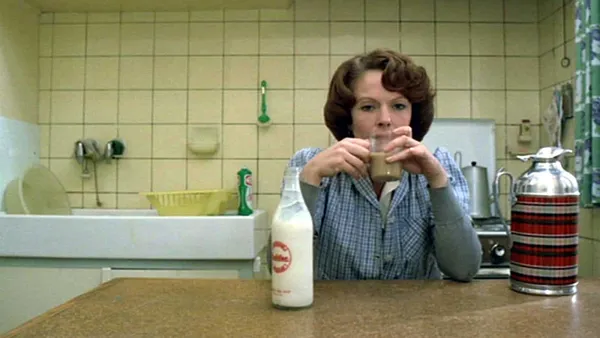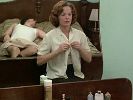Eye For Film >> Movies >> Jeanne Dielman, 23 Commerce Quay, 1080 Brussels (1975) Film Review
Jeanne Dielman, 23 Commerce Quay, 1080 Brussels
Reviewed by: Donald Munro

Editor's note: This is a review of a classic, much-studied film, and contains plot spoilers.

Jeanne Dielman, 23, Quai Du Commerce, 1080 Bruxelles is the second full length film by Chantal Akerman that has a distinct narrative. It is three days in the life and context of Jeanne Dielman (Delphine Seyrig).
Jeanne goes about her daily routine. It is repetitive and meticulously ordered. Each action she takes is taken at the correct time and in the correct sequence. She cleans, cooks; as a prostitute she has sex with one of her client; serves food to her son Sylvain (Jan Decorte) on his return from school, listens to the radio, leaves the apartment with Sylvain for some unexplained reason and on return goes to bed. Every piece of fabric she comes across, she folds with obsessive purpose. Her existence seams dull and boring. The colour scheme in her apartment is drab; what few ornaments there are, are kept behind glass in a cabinet. The meals that she serves are colourless and bland. They make British cooking from the Seventies look like a culinary delight, boiled ham with a pineapple ring, the red cherry a visual extravaganza.
Red is a colour that is almost excluded from Jeanne's interior existence. There is the muted label on the never-drunk-from beer bottle that is always placed on the dining table alongside the faded red napkins. A tin can brought back from the shops - tomatoes? - is quickly hidden away in a kitchen cupboard. Outside the apartment, red exists, but Jeanne has something of an aversion to it. On her first visit to the post office she hurries past the post box and stamp machine.
Akerman maintains the drab colour palette of the interiors in her exterior shots, but then populates those shots with with bright red objects, cars, signs and peoples clothing. Outside of Jeanne's world people live colourful, vibrant lives.
During the second day, Jeanne's routine starts to become disrupted. She forgets to replace the lid on the urn where she puts the money from her clients. Her carefully timed sequence of actions is out of whack and her potatoes are over boiled. Pot in hands, she scuttles from room to room like a confused insect, not knowing what to do. On the third day her life becomes more disordered. After failing to buy a replacement button for a coat, she finds that the post office is closed. When she's trying to use the red stamp machine, a man interacts with her, telling her that the machine is empty. When she gets to the café where she would get coffee, her usual seat is taken and the waitress who serves her has clocked off. On returning home, as she always does, she checks the mailbox in the apartment building's foyer. Empty, but there is a parcel on the floor. Opened with a pair of scissors, it contains a garment. Jeanne folds. The doorbell goes, a client. Jeanne places the scissors on a dresser, not their proper place, undresses and folds her clothes. Then she does something she never does. She has an orgasm. After dressing she stabs the man to death with the pair of rogue scissors. In the final shot of the film she sits at the dining table, red on her hand and red on her white blouse.
Jeanne Dielman, 23, Quai Du Commerce, 1080 Bruxelles is often interpreted as a feminist polemic speaking against a world that stifled - and 50 years later still stifles - women's potential, placing them into domestic drudgery. Another, which could sit along side that interpretation, is that it is the study of an atypical neurology. Jeanne Dielman is, in her way, living a life that she has chosen. 23, Quai Du Commerce, 1080 Bruxelles is her home. Its décor is hers. The routines she follows are her routines. She has opportunities in the film to interact with people in a more emotionally meaningful way, but she does not. Her apartment shields her from a world that is too loud, too colourful, too emotional.
In 2022, Jeanne Dielman, 23, Quai Du Commerce, 1080 Bruxelles topped Sight And Sound's Greatest Films Of All Time. It was a somewhat controversial choice. A number of mostly male commentators were a put out by it. The truth is that it is not the best film of all time. Then again, neither was Citizen Kane. Wells made better: The Trial and Chimes At Midnight; and performed in better: The Third Man. It's debatable whether any film can really hold that accolade. Akerman's film is very good but it has its problems, which can be summed up as accessibility.
Jeanne Dielman, 23, Quai Du Commerce, 1080 Bruxelles is a long film with sparse dialogue. For the first hour and a half nothing happens, superficially. Some might compare it to watching paint dry. It's not paint; it's undercoat. It's preparing the canvas for the rest of the film. It requires a lot of patience to watch. If attention drifts at the wrong moment, a detail vital to understanding the final two hours is missed. The viewer has to be keyed into Akerman's cinematic language, how she portrays boredom, claustrophobia, isolation. After dark, the main room in the apartment is subjected to a faint blue strobing light. Four bars pulse down and then quickly ripple up. It strains the eye. Some will find it incredibly annoying. In all, it is a difficult film to watch.
The significance of Jeanne Dielman, 23, Quai Du Commerce, 1080 Bruxelles cannot be ignored. It is an important part of the feminist artistic discourse. It pushed the boundaries of what can be put on film and introduced new elements to cinematic language, bringing in ideas from the avant-garde art of the New York scene. Many films have been influenced by it. There is the sound design in Girl With A Pearl Earring with the foregrounding of the sounds of domestic chores; and there is the framing in Portrait Of A Lady On Fire.
Reviewed on: 20 Feb 2025















